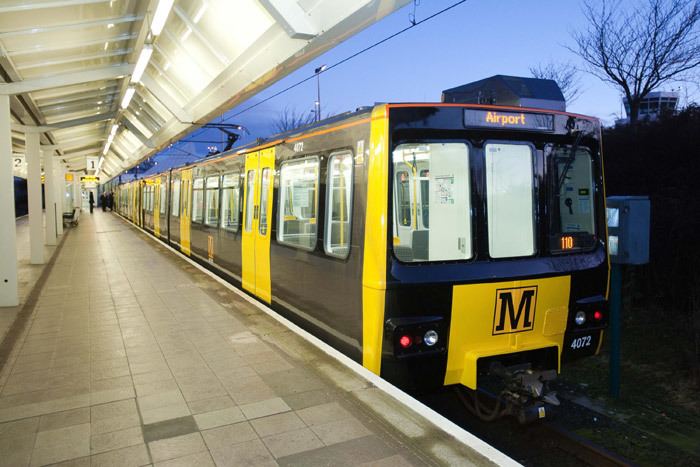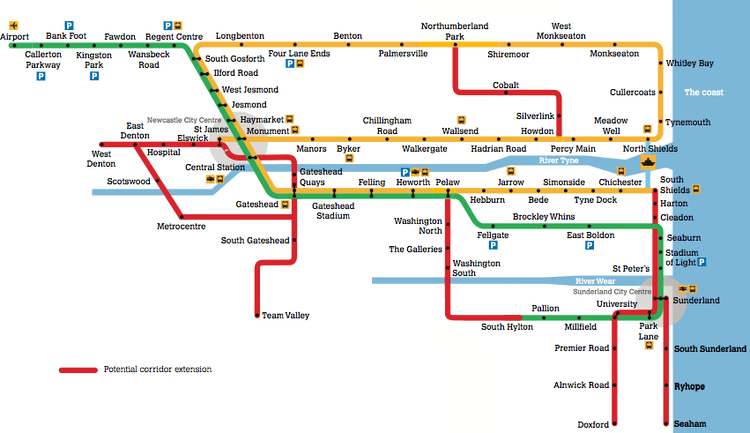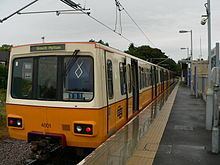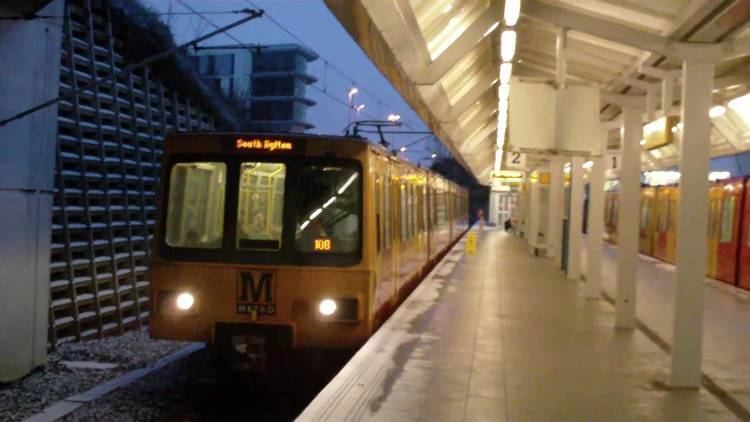Status In Use Daily ridership 109,600 (2015) Depot Gosforth | Ridership Over 40 million (2015) Stations 60 | |
 | ||
Operators Tyne and Wear Passenger Transport Executive, Arriva UK Trains | ||
Metro in newcastle uk tyne and wear metro 2016
The Tyne and Wear Metro, referred to locally as simply The Metro, is a rapid transit and light rail system in North East England, serving Newcastle upon Tyne, Gateshead, South Tyneside, North Tyneside and Sunderland in the Tyne and Wear region. It has been described as the first modern light rail system in the United Kingdom.
Contents
- Metro in newcastle uk tyne and wear metro 2016
- Tyne and wear metro
- Predecessor
- Planning and construction
- Further extensions
- Opening dates
- Metric
- Integration
- Part privatisation
- Routes and services
- Services
- Rolling stock
- Stations
- Artwork
- 61st station Beacon Hill
- Tunnels
- Layout
- Distances
- Electrification
- Branding and identity
- Metro All Change programme Phase 1
- Metro All Change programme Phase 2
- Metro All Change programme Phase 3
- Proposed extensions and suggested improvements
- References

The initial network opened between 1980 and 1984, using converted former railway lines, linked with new tunnel infrastructure. Extensions to the original network were opened in 1991 and 2002. In 2015/16 40 million passenger journeys were made on the network, which spans 77.5 kilometres (48.2 mi) and has two lines with a total of 60 stations, nine of which are underground. It is the second-largest of the four metro systems in the United Kingdom, after the London Underground; the others being the Docklands Light Railway and the Glasgow Subway.

The system is owned by the local transport authority Nexus, and since 2010 has been operated under contract by DB Regio Tyne & Wear Limited, a subsidiary of Arriva UK Trains. In April 2017, this contract will end, and Nexus will take over direct operation of the system for a planned period of two years.
Tyne and wear metro
Predecessor

The present system uses much former railway infrastructure, mostly constructed between 1839 and 1882. One of the oldest parts being the Newcastle & North Shields Railway opened in 1839. In 1904, in response to tramway competition which was taking away passengers, the North Eastern Railway (NER) started electrifying parts of their local railway network north of the River Tyne with a 600V DC third-rail system, forming one of the earliest suburban electric networks, known as the Tyneside Electrics. In 1938, the line south of the Tyne between Newcastle and South Shields was also electrified. In the 1960s under British Rail, the decision was made to de-electrify the Tyneside Electric network, and convert it to diesel operation, this was due to falling passenger numbers, and the cost of renewing life expired electrical infrastructure and rolling stock. The Newcastle-South Shields line was de-electrified in 1963, and the north Tyneside routes were de-electrified in 1967.
Planning and construction

In the early-1970s, the poor local transport system was identified as one of the main factors holding back the region's economy, and in 1971 a study was commissioned by the recently created Tyneside Passenger Transport Authority (now known as 'Nexus') into how the transport system could be improved; this study recommended reviving the badly run down former Tyneside Electric network, by converting it into an electrified rapid transit system, which would include new underground sections to better serve the busy central areas of Newcastle and Gateshead. This new system was intended to form the centrepiece of an integrated transport network, with buses acting as feeders to purpose-built interchanges. The plans were approved by the Tyneside Metropolitan Railway Bill which was passed by Parliament in July 1973. Around 70% of the funding for the scheme came from a central government grant, with the remainder coming from local sources.

Three railway lines, totalling 26 miles (42km) were to be converted into Metro lines as part of the initial system; the North Tyneside Loop, and the Newcastle-South Shields branch (both of which were formerly part of the Tyneside Electric network) also a short stretch of the freight-only Ponteland branch, between South Gosforth and Bank Foot, which had not seen any passenger traffic since 1929. The converted railway lines were to be connected by around six miles (10km) of new infrastructure, which was built both to separate the Metro from the existing rail network, and also to create the new underground routes under Newcastle and Gateshead. Around four miles (6.4km) of the new infrastructure was in tunnels, while the remainder was either at ground level or elevated: The elevated sections included the new 350 metre Queen Elizabeth II Bridge; a dedicated bridge carrying the Metro across the River Tyne, and the 820 metre Byker Viaduct across the Ouseburn Valley, between Byker and Manors stations.
Construction work began in October 1974; this involved the construction of the new infrastructure, re-electrifying the routes with overhead line equipment, the upgrading or relocation of existing stations, and the construction of several new stations, some of which were underground. Originally it was intended to be opened in stages between 1979 and 1981, however, in the event, the first part of the original network opened in August 1980, and the remainder opened in stages until March 1984.
Further extensions
Some extensions to the original system have since been built. A short 3.5km extension from Bank Foot to Newcastle Airport was opened in 1991, using a further part of the former Ponteland branch.
In 2002 an 11-mile (18.5 km) extension was opened from Pelaw to South Hylton via Sunderland. Costing £100 million, this extension used part of the existing Durham Coast Line to Sunderland, but did not take it over; instead the line between Pelaw and Sunderland was adapted to allow a shared service between the Metro and the conventional rail services, becoming the first UK system to implement a form of the Karlsruhe model. Three intermediate stations on the route were rebuilt, and three new ones were added. Within Sunderland, 4.5km of a former freight line which had been abandoned in 1984, was reused for the route between Sunderland station and South Hylton, becoming the second Metro segment to be built on a disused line.
Opening dates
The opening dates of the services and stations are as follows:
Metric
The Tyne and Wear Metro was the first railway in the UK to operate using the metric system; all its speeds and distances are stated in metric units only.
Integration
When the Metro opened it was intended to form part of an integrated public transport system, with the local bus network reconfigured to act as 'feeders' for the Metro. Metro was intended to cover trunk journeys, while buses were reoriented toward shorter local trips, integrated with the Metro schedule, to bring passengers to and from Metro stations, using unified ticketing. Integration lasted until deregulation of bus routes in 1986. It is however still possible to buy Transfare tickets that combine a Metro and bus journey.
Part privatisation
Metro is publicly owned, receiving funding from council tax payers and government. Nexus, which owns and manages Metro, contracted out operations and train maintenance as part of a deal with the UK Government to secure modernisation investment and operating subsidy for the system between 2010 and 2021. Nexus continues to set fares, set frequency of services and Metro operating hours. Opponents say this was privatisation by the back door, though some services had already been contracted out, such as cleaning of stations and ticket inspections. On 3 November 2008, Nexus invited potential bidders to declare an interest in a contract to run the operations side of the business on its behalf. The successful bidder was to obtain a seven-year contract commencing on 1 April 2010, with up to an additional two years depending on performance. In February 2009 four bids were shortlisted; DB Regio, MTR Corporation, Serco-NedRailways, and an in-house bid by Metro. By October 2009 the shortlist had been reduced to bids from DB Regio and Nexus. In December 2009, DB Regio was named as the preferred bidder. The contract for operating the system was signed on 2 February 2010, and the service was handed over to DB Regio on 1 April 2010.
One of DB Regio's first initiatives was called Metro Dig It and involved the re-painting of stations and deep-cleaning of stations and trains.
On 3 February 2010 the Government confirmed it would award Nexus up to £580 million to modernise and operate the Tyne and Wear Metro. Up to £350 million was to be spent on the 'Metro: All change programme' over the next eleven years. A further £230 million would support running and maintenance costs over the next nine years.
In March 2016 Nexus announced that it did not intend to renew the contract with DB Regio, which will expire in April 2017, from that date, Nexus will take over direct operation of the system for a planned period of two years, until a new operating contract can be agreed. The RMT union however, has argued that the direct operation should be made permanent, and operation of the system should remain in public ownership.
Routes and services
The Metro consists of two lines, the Green Line, which runs between Newcastle Airport and South Hylton (via Newcastle city centre, Gateshead and Sunderland) and the Yellow Line, which runs between St James and South Shields (via North Shields, Tynemouth and Whitley Bay), then looping back on itself and going south (via the city centre, Gateshead and Jarrow).
List of routes: Stations in bold indicate terminating stations
Originally, there was also a Red line between Heworth (later Pelaw) and Benton and a Blue line between St James and North Shields. Additional trains ran on these lines during peak hours to increase the frequency at the busier stations. Many of these additional services still operate as Yellow line services.
Services
Daytime services on each line operate every 12 minutes: on the shared section between South Gosforth and Pelaw this rises to every six minutes. Services operate from around 5:30 until midnight. A full journey on the Green Line between Airport and South Hylton takes 67 minutes. The Yellow Line consists of the North Tyneside Loop, and the branch to South Shields; a full journey around the loop takes 54 minutes, and the full route from St James to South Shields takes 82 minutes.
Metro does not allow the carriage of standard bicycles, though there are storage lockers for these at some stations. Only small folding bicycles are permitted on the Metro, and technically only Nexus-approved models of folding bikes are permitted. Photography is allowed on Metro but written permission is required. Furthermore, Nexus reserves the right to chaperone any filming or photography taking place on the network, and has often insisted upon doing so. This rule however does not apply to Sunderland station, because of its being owned by Network Rail and managed by Northern.
In 2005 the penalty fare for travelling without a valid ticket was increased from £10 to £20.
Smoking has been forbidden since opening; this was one of the first comprehensive smoking bans.
Rolling stock
Since the inception of the Tyne and Wear Metro, its rolling stock has remained the same. Its passenger fleet, comprises a total of 90 two-car articulated units, known as 'Metrocars', which are numbered 4001–4090: these can operate singly, but are usually coupled together in pairs, and have a maximum speed of 80km/h (50 mph). The first units to be built were two prototypes, numbered 4001 and 4002, which were delivered for testing in 1975, and are still in service, these were followed by 88 production units, which were built between 1978 and 1981. The design of the Metrocars was based on the Stadtbahnwagen B, a German light rail vehicle, developed in the early 1970s, however they were built in Britain by Metro Cammell at their factory in Birmingham.
The fleet has been refurbished several times, with various liveries, the original livery being yellow and white. A half-life refurbishment took place in the mid-1990s, and a red, green or blue livery was adopted. Another full refurbishment of the fleet took place between 2010 and 2015: known as the 'three-quarter-life' refurbishment, the Metrocars were refurbished by Wabtec Rail at its Doncaster facility, with the main goal being to extend their service life until 2025. Each car was stripped down to its frame and built back up again, with the addition of improved disabled access, new door control systems, and renewed interiors, seating and lighting. A new yellow and black livery was also adopted.
Nexus have made replacing the ageing fleet of trains, which have been in constant service since 1980, and suffer reliability problems, a priority. In 2016 plans were unveiled to secure funding for a new £550 million replacement fleet, with a target for them to be in service by the early 2020s. The proposed new fleet is planned to have dual voltage capability, able to operate on the Metro's existing 1.5 kV DC electrification system and also the 25 kV AC used on the national rail network, to allow greater flexibility. battery technology is also being considered.
In addition to its passenger trains, the Tyne and Wear Metro also owns and operates three battery-electric locomotives, constructed by Hunslet in 1988 and numbered BL1, BL2 & BL3, as well as a Plasser & Theurer 08-275 NX ballast tamper and 15 wagons.
Stations
The 60 stations on the Metro, vary widely in character, some are former railway stations, while others were purpose built for the Metro. Most of the stations are above ground, but several in central Newcastle and Gateshead are underground, these are Central Station (under Newcastle railway station) Jesmond, Haymarket, Monument, Manors, St James and Gateshead, on the Sunderland extension, Park Lane and Sunderland stations also have underground platforms.
Three of the stations have interchange with National Rail services; Central Station, Heworth and Sunderland, which, uniquely is the only station in Britain where light and heavy rail services use the same platforms.
All Metro stations are unstaffed, with the exception of the underground stations, which are required to be staffed by law. All stations are equipped with ticket machines, shelters, information displays, next-train indicators and passenger information/emergency help-points.
Metro installed ticket barriers at 13 stations on the network during a modernisation programme in 2013–2014, while the remaining stations have no fixed ticket controls. Despite this, the Tyne and Wear Metro has the third-highest level of passenger income per year (£45.2 million in 2013/2014) of the eight light rail systems in England. Checks are made by roving patrols of inspectors. Ticket machines that accept coins, notes and credit/debit cards were introduced during the modernisation programme.
Metro pioneered the playing of classical music in some of its stations to deter vandalism. In 1998 Frederick Delius's Incidental Music to Hassan was chosen by Metro to be played over its public address system as a deterrent to vandals.The Director General of Nexus was quoted as saying: "The aim is not to soothe but to provide a background of music that people who we are aiming at don't actually like and so they move away. It's been pretty successful." In 2005 the London Underground began to follow Metro's example.
Artwork
Many stations throughout the system feature commissioned works by various artists. Examples include the following:
61st 'station' – Beacon Hill
A mock station, named Beacon Hill, was installed in late 2010 at Beacon Hill School in Wallsend, North Tyneside. It features a building painted like a Metro train, with working passenger doors, standing at a recreated station building, which features a lifelike ticket hall with working ticket machines, a recreated platform area with tactile paving, authentic passenger seating, yellow litter bins and railings and an illuminated Metro "cube" outside. The 'station' was installed at the school in association with Nexus to assist with teaching local children how to travel by Metro, encouraging safe independent travel.
Tunnels
Under Newcastle city centre, two routes run underground at right angles to each other, and intersect at Monument Metro station which has four platforms on two levels. One route shared by the yellow and green lines, runs from north to south, diving underground at Jesmond Metro station at the north, and running south via Haymarket, Monument and Central Station, before rising above ground to cross the Queen Elizabeth II Bridge over the Tyne, and then entering another tunnel running under Gateshead town centre, serving Gateshead Interchange, it then rises above ground again in between Gateshead and Gateshead Stadium Metro station.
A second underground route, part of the yellow line, runs from east to west, diving underground from the east under the East Coast Main Line, before serving Manors Metro station, then Monument station (interchanging with the north-south route) and then terminating at St James Metro station. Yellow Line trains running from St James pass through Monument station twice, once eastbound through the east-west platforms, and then, after running around the North Tyneside Loop, southbound through the north-south platforms before running to South Shields.
A short spur line, partly in tunnel, runs from Manors to Jesmond; this line is used for empty stock movements only, and has no passenger service. Before the Metro tunnels were created, it was part of the main line route to Newcastle railway station and connected to the main line at Manors railway station.
The tunnels were constructed in the late 1970s, using mining techniques, and were constructed as single-track tubes with a diameter of 4.75 metres. The tunnels under Newcastle were mechanically bored through boulder clay and lined with cast iron or concrete segments. The tunnel under Gateshead, was bored through sandstone and excavated coal seams. Old coal mine workings, some of which dated to the middle ages had to be filled in before the tunnelling began.
Layout
Metro was the first rapid-transit system in the world with a "pretzel" configuration, in which a line crosses over itself and trains pass through the same station twice at different platforms, as Yellow line trains do at Monument station. It was joined in having such configurations by the Vancouver SkyTrain in Canada and the RandstadRail tram system in the Netherlands in 2006. Toronto had previously experimented with a pretzel configuration in 1966.
Distances
Distances on the system are measured from a datum point at South Gosforth. The system is metric, with distances in kilometres to the nearest metre. Lines are designated In and Out. The In line is from St. James to South Shields via the inside of the loop (Yellow Line); the Out line is the opposite. By extension the In line is from Airport to South Gosforth, and from Pelaw to Sunderland and South Hylton. Distance plates are mounted on all overhead line structures. Different distances are normally quoted for stations, depending on whether the direction of travel is In or Out. Distances increase from the datum in all directions.
The part of the Sunderland extension owned by Network Rail is dual-marked in metric units and the miles and chains system used by mainline trains. The boundary between the two systems is close to Pelaw Metro Junction. The closest adjacent stations are St Peter's and Sunderland; the furthest apart Pelaw and Fellgate.
Electrification
The Tyne and Wear Metro is electrified with overhead lines at at 1,500 V DC, it is now the only rail network in Britain to use this system. Nexus have stated that their long term ambition, is to convert the electrification of the Sunderland line which is shared with main line trains, to the Network Rail standard of 25kv AC, which would require a new fleet of dual voltage trains.
Branding and identity
The Metro has a distinctive design and corporate identity, to distinguish itself from the decrepit rail system it replaced and to match the livery of the buses then in use. The Calvert typeface, used for signage and in printed materials, was designed specifically for the Metro by Margaret Calvert. The corporate identity was revised in 1998, de-emphasising the Calvert font, and adding the word Metro to its M logo. A further revision made in 2008, and subsequently rolled out, re-emphasises the Calvert font, most obviously in posters and in signage at the refurbished Haymarket station in the centre of Newcastle.
'Metro: All Change programme' Phase 1
New ticket machines accepting notes and cards at all stations and barriers at 13 main stations were installed between 2011 and 2014. The modernisation of Haymarket station, funded through private development, was completed on 29 March 2010, and a new station at Simonside opened in March 2008. An upgrade of platforms at Sunderland and the modernisation of several other stations was included in this phase.
Lifts have been replaced at several Metro stations since 2009 as part of the programme. The programme also includes overhauling infrastructure including communications, track and overhead power lines, structures and embankments.
'Metro: All Change programme' Phase 2
Refurbishment of 90 Metro trains and modernisation of 45 stations, a new communications system, overhaul and maintenance of structures such as bridges, tunnels, track and overhead power lines. North Shields station has also been rebuilt. This work started in 2010 and cost £255.3m. Refurbishment of the Metro trains commenced during the summer of 2010, with 4041 being the first one to undergo a nine-month rebuild; this included a new livery and a new interior.
'Metro: All Change programme' Phase 3
Procurement of a new fleet of Metrocar trains, a new signalling system, overhaul and maintenance of structures, track and overhead lines, and further station improvements. This work is scheduled to start in 2019. Funding for this phase has yet to be secured, and the scheme is being criticised due to the fact that the Metro fleet will be almost 40 years old when replacement begins, even though the fleet has an original design life of approximately 30 years. In October 2016 it was announced that Nexus was to submit a bid to the Department for Transport in order to gain funding for new trains.
Proposed extensions and suggested improvements
In 2002, Nexus unveiled an expansion plan to extend the system by adding new sections using street running, changing the Metro into a high-end tram system. Nexus argued that this would provide a cost-effective way to introduce rail service to parts of Tyne and Wear the current Metro services did not reach. The plan listed a number of routes, not all of which were to be built as rail lines; transitional bus services were envisioned, and these could be replaced by trams as demand increased. The original Project Orpheus has been abandoned, possibly because of the government's present "value-for-money" policies for public transport. The use of trams in Tyne & Wear is now less likely, with additional public transport schemes being based around the use of buses.
Nexus has struggled to gain funding for improvements to the existing system, so any extensions are simply part of a long-term vision. Below is a list of previously mooted extensions:
